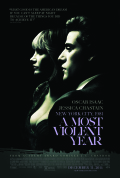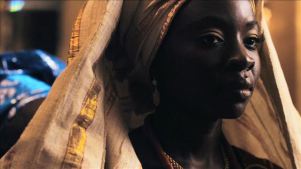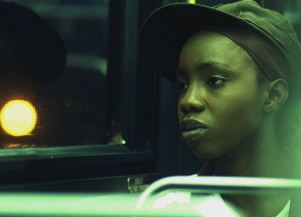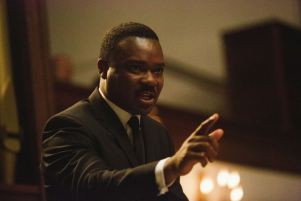

Bradford Young’s work on Ava DuVernay’s civil rights biopic Selma and JC Chandor’s A Most Violent Year landed him on Hollywood’s radar this Oscar season, but it also illuminates the diversity lacking year after year within the film industry and the Academy that represents it. Critics and DuVernay have praised Young’s aptitude for lensing African-American faces onscreen as beautifully as he does in Selma, 
a film about Martin Luther King, Jr.’s private and public struggles to turn the tide of the voting rights movement. “I’m never satisfied with the way I see my people photographed in movies,” Young confessed to me over the phone before the holidays. “I think it comes from a lack of consciousness – if you grew up in a community where you don’t know black people, I wouldn’t suspect you would photograph them in a concerned way.”
Few working cinematographers today trained like Young, who lives in Washington D.C. and spent years honing his photographic skills on subjects of color.  “I went to a majority black elementary school, a majority black high school, I moved to Chicago when I was 15 and lived on the Southside in a majority black community,” he said. “All of the artists that my grandparents collected were black artists. All of the books on my grandparents’ shelf, my father’s shelf, my mother’s shelf, were about black people. My world, until I got to D.C., was really about blackness.”
“I went to a majority black elementary school, a majority black high school, I moved to Chicago when I was 15 and lived on the Southside in a majority black community,” he said. “All of the artists that my grandparents collected were black artists. All of the books on my grandparents’ shelf, my father’s shelf, my mother’s shelf, were about black people. My world, until I got to D.C., was really about blackness.”
At Howard University, Young studied under Haile Gerima and soaked up the work of DPs who came before him. “Ernest Dickerson, who was Spike Lee’s preferred cinematographer, went to Howard,” he said. “Arthur Jafa, who was Spike’s cinematographer on Crooklyn and was Julie Dash’s cinematographer on Daughters Of The Dust, went to Howard. Malik Sayeed, the incredible, talented, gifted god of lighting black folk, went to Howard as well. It was a treasure chest of references for me to imitate, mimic, and pay homage to. My training was geared toward exposing my community — this particular community.”
 Those watching the indie scene have seen Young on the rise in recent years. He won the Sundance cinematography prize for Dee Rees’ Pariah in 2011, the same year he shot fellow Sundance class of 2011 entry Restless City for Andrew Dosunmu. In 2012 he teamed with DuVernay on her Sundance-winning drama Middle Of Nowhere, which won the future Selma helmer top directing honors. Last year Young won the Sundance cinematography prize again for lensing Dosunmu’s Mother Of George and David Lowery’s Ain’t Them Bodies Saints.
Those watching the indie scene have seen Young on the rise in recent years. He won the Sundance cinematography prize for Dee Rees’ Pariah in 2011, the same year he shot fellow Sundance class of 2011 entry Restless City for Andrew Dosunmu. In 2012 he teamed with DuVernay on her Sundance-winning drama Middle Of Nowhere, which won the future Selma helmer top directing honors. Last year Young won the Sundance cinematography prize again for lensing Dosunmu’s Mother Of George and David Lowery’s Ain’t Them Bodies Saints.
“I have a deep concern about humanity, period,” Young said. “Ain’t Them Bodies Saints spoke to me because those are the grandchildren in time and spirit of all those amazing white folk during the Great Depression and the Dust Bowl who were subversive against Jim Crow. They were like, we’re going to throw down our own ignorance so we can all share the plow together. That for me is a glorious golden age in American history because it was the first time Americans were really invested in socialism, and I saw that in that script. There was no room for fascism and racism when you couldn’t eat.”
 “Something like Selma, or Mother Of George, or Pariah — I know those people very well,” said Young. “They’re my grandparents, my aunts and uncles, my cousins. When I see Alike or Martin Luther King, I see my family. I love my family, so I wouldn’t photograph them any differently. And that’s a universal principle, whether you’re a white cinematographer or a Southeast Asian cinematographer. When you care about your people you’re going to do right by them, and that doesn’t have any technical boundaries.”
“Something like Selma, or Mother Of George, or Pariah — I know those people very well,” said Young. “They’re my grandparents, my aunts and uncles, my cousins. When I see Alike or Martin Luther King, I see my family. I love my family, so I wouldn’t photograph them any differently. And that’s a universal principle, whether you’re a white cinematographer or a Southeast Asian cinematographer. When you care about your people you’re going to do right by them, and that doesn’t have any technical boundaries.”
If nominated for an Oscar on January 15, the 37-year-old Louisville native will become only the second black cinematographer in history to earn an Academy Award nom. (Remi Adefarasin was the first with his nod for 1998’s Elizabeth.) It wouldn’t just be a historic moment for Young, the youngest contender in recent years in his field. DuVernay is the first black female director to earn a Golden Globe nomination for Best Director for Selma and the film is eyeing multiple categories at the Oscars.
Timing has been prescient for Selma, which Paramount released on Christmas on the heels of Ferguson and at the tail end of a year of unprecedented social action and outrage over race politics in America.
 “I don’t want to make this overtly political, but I think it is overtly political, because I think in general Americans don’t know their history,” said Young. “And when you don’t know your history, you can’t humanize people that you subjected to mass social disenfranchisement, police brutality, slavery, sexism, xenophobia. When you’re not dealing with that as part of your history, you have no concern or care to represent those people in mass media in a real conscious way. My pedagogy around filmmaking is that it’s a medium that can raise the stakes for all of humanity.”
“I don’t want to make this overtly political, but I think it is overtly political, because I think in general Americans don’t know their history,” said Young. “And when you don’t know your history, you can’t humanize people that you subjected to mass social disenfranchisement, police brutality, slavery, sexism, xenophobia. When you’re not dealing with that as part of your history, you have no concern or care to represent those people in mass media in a real conscious way. My pedagogy around filmmaking is that it’s a medium that can raise the stakes for all of humanity.”
“Someone asked Ava at a Q&A, ‘Is this film timely?’ ” he continued. “She said, ‘It’s always going to be timely, because times haven’t changed for us.’ When you think about it that way it’s not about being timely, it’s just highlighting our continuous struggle to be human beings in the world.”
Jen Yamato
